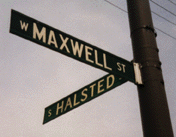Clan Maxwell Society
Celebrating the Scottish Heritage of Maxwells and their Allied Families
Adair • Blackstock • Dinwiddie/Dinwoodie/Dinswoodie • Edgar • Herries • Kirl • Kirkland • Latimore/Latimer • MacKittrick • Maxton • Monreith • Moss • Nithsdale • Peacock • Pollock/Pollok • Polk/Paulk • Rawlins • Sturgeon • Wardlaw
Chicago’s Maxwell Street Lives On


Maxwell Street in Chicago is well known by fans of blues music, and it has become familiar to others over the past decade as the focal point of a battle for historic preservation. Named for Dr. Philip Maxwell, an early Chicago settler, the street was an immigrant destination almost from its start. First came waves of Germans, Italians and Irish. Then came the Greeks, Bohemians and Russians. And, in the 1880s, Jews began to arrive from Russia and eastern Europe.
Each group of immigrants brought its traditions with them, and one led to the Maxwell Street Market. It began with push carts, then permanent stands, then store fronts behind the stands with rooms above for the shopkeepers’ families. Styled very much after European markets, it has operated since 1880.
After World War I, the neighborhood began changing yet again as African-Americans from the south began migrating north in huge numbers. Like other migrant groups before them, they found their way to Maxwell Street. And they brought a tradition of outdoor entertainment, with blues musicians playing their guitars and harmonicas on street corners for whatever a listener might drop into their tin cups. The urban sound meshed with Delta blues to produce what became known as the Chicago Blues, giving us such blues legends as Muddy Waters and Bo Diddley.
Maxwell Street began to shrink after the 1920s, squeezed in by new railroad tracks, a new expressway, and construction of the Circle Campus of the University of Illinois at Chicago. By the late 1960s, only a few blocks of the old neighborhood remained, with the corner of Maxwell and Halsted as its epicenter, and the Market had become primarily a weekend affair.
As university, city, and private developers set their sights on what remained of this neighbor- hood with its proximity to the Loop, a movement arose to preserve what little was left. An attempt to have the area added to the National Register of Historic Places failed, but that did not stop activists. In the spring of 1999, the University proposed to preserve eight buildings in place and attach the facades from 13 others to new structures. While far less than what the preservationists wanted, it ensured that Maxwell Street’s unique and historic character will continue into the new millennium.
Copyright © 2001 — 2023 | All Rights Reserved | Maxwell Writers Group
Site design KWGraphicsandWeb